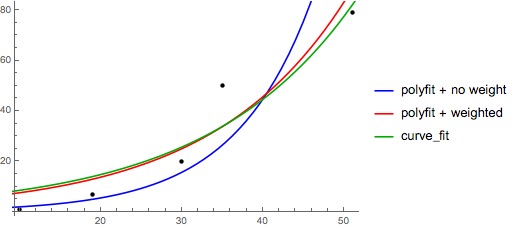我有一组数据,我想比较哪一种曲线可以最好地描述它(不同阶的多项式,指数或对数)。
我使用Python和Numpy,多项式拟合有一个函数polyfit()。但是我没有发现这样的指数和对数拟合函数。
有没有?或者如何解决呢?
最佳解决思路
为了拟合y = A + B log x,只需要将y代入(log x)。
>>> x = numpy.array([1, 7, 20, 50, 79])
>>> y = numpy.array([10, 19, 30, 35, 51])
>>> numpy.polyfit(numpy.log(x), y, 1)
array([ 8.46295607, 6.61867463])
# y ≈ 8.46 log(x) + 6.62
为了拟合y = AeBx,取双方的对数给出logy = logA + Bx。所以适合(logy)对x。
请注意,拟合(log y)好像是线性的,会强调y的小值,导致大y的偏差较大。这是因为polyfit(线性回归)通过最小化Σi(ΔY)2 =Σi(Yi-Ŷi)2来工作。当Yi = log yi时,残差ΔYi=Δ(log yi)≈Δyi/| yi |。所以即使polyfit对于大y做出了一个非常糟糕的决定,”divide-by-|y|”因子也会补偿它,导致polyfit偏好较小的值。
这可以通过给每个条目一个与y成比例的”weight”来减轻。 polyfit通过w关键字参数支持weighted-least-squares。
>>> x = numpy.array([10, 19, 30, 35, 51])
>>> y = numpy.array([1, 7, 20, 50, 79])
>>> numpy.polyfit(x, numpy.log(y), 1)
array([ 0.10502711, -0.40116352])
# y ≈ exp(-0.401) * exp(0.105 * x) = 0.670 * exp(0.105 * x)
# (^ biased towards small values)
>>> numpy.polyfit(x, numpy.log(y), 1, w=numpy.sqrt(y))
array([ 0.06009446, 1.41648096])
# y ≈ exp(1.42) * exp(0.0601 * x) = 4.12 * exp(0.0601 * x)
# (^ not so biased)
请注意,Excel,LibreOffice和大多数科学计算器通常使用指数回归/趋势线的未加权(有偏)公式。如果您希望您的结果与这些平台兼容,即使提供了更好的结果,也不要包含权重。
现在,如果有scipy,你可以使用scipy.optimize.curve_fit来适应没有转换的任何模型。
对于y = A + B log x,结果与转换方法相同:
>>> x = numpy.array([1, 7, 20, 50, 79])
>>> y = numpy.array([10, 19, 30, 35, 51])
>>> scipy.optimize.curve_fit(lambda t,a,b: a+b*numpy.log(t), x, y)
(array([ 6.61867467, 8.46295606]),
array([[ 28.15948002, -7.89609542],
[ -7.89609542, 2.9857172 ]]))
# y ≈ 6.62 + 8.46 log(x)
对于y = AeBx,我们可以更好地拟合,因为它直接计算Δ(log y)。但是我们需要提供初始化猜测,以便curve_fit可以达到所需的最小值。
>>> x = numpy.array([10, 19, 30, 35, 51])
>>> y = numpy.array([1, 7, 20, 50, 79])
>>> scipy.optimize.curve_fit(lambda t,a,b: a*numpy.exp(b*t), x, y)
(array([ 5.60728326e-21, 9.99993501e-01]),
array([[ 4.14809412e-27, -1.45078961e-08],
[ -1.45078961e-08, 5.07411462e+10]]))
# oops, definitely wrong.
>>> scipy.optimize.curve_fit(lambda t,a,b: a*numpy.exp(b*t), x, y, p0=(4, 0.1))
(array([ 4.88003249, 0.05531256]),
array([[ 1.01261314e+01, -4.31940132e-02],
[ -4.31940132e-02, 1.91188656e-04]]))
# y ≈ 4.88 exp(0.0553 x). much better.

次佳解决思路
您也可以使用来自scipy.optimize的curve_fit来拟合一组数据。例如,如果你想拟合一个指数函数(来自documentation):
import numpy as np
import matplotlib.pyplot as plt
from scipy.optimize import curve_fit
def func(x, a, b, c):
return a * np.exp(-b * x) + c
x = np.linspace(0,4,50)
y = func(x, 2.5, 1.3, 0.5)
yn = y + 0.2*np.random.normal(size=len(x))
popt, pcov = curve_fit(func, x, yn)
然后如果你想要绘制图像(plot),你可以这样做:
plt.figure()
plt.plot(x, yn, 'ko', label="Original Noised Data")
plt.plot(x, func(x, *popt), 'r-', label="Fitted Curve")
plt.legend()
plt.show()
(注意:当你绘图的时候,*之前的*会将这些条件扩展到func所期望的a,b和c中。)
第三种解决思路
我在这方面遇到了一些麻烦,所以让我说得更细致清楚一些,以便像我这样的新手可以理解。
比方说,我们有一个数据文件或类似的东西
# -*- coding: utf-8 -*-
import matplotlib.pyplot as plt
from scipy.optimize import curve_fit
import numpy as np
import sympy as sym
"""
Generate some data, let's imagine that you already have this.
"""
x = np.linspace(0, 3, 50)
y = np.exp(x)
"""
Plot your data
"""
plt.plot(x, y, 'ro',label="Original Data")
"""
brutal force to avoid errors
"""
x = np.array(x, dtype=float) #transform your data in a numpy array of floats
y = np.array(y, dtype=float) #so the curve_fit can work
"""
create a function to fit with your data. a, b, c and d are the coefficients
that curve_fit will calculate for you.
In this part you need to guess and/or use mathematical knowledge to find
a function that resembles your data
"""
def func(x, a, b, c, d):
return a*x**3 + b*x**2 +c*x + d
"""
make the curve_fit
"""
popt, pcov = curve_fit(func, x, y)
"""
The result is:
popt[0] = a , popt[1] = b, popt[2] = c and popt[3] = d of the function,
so f(x) = popt[0]*x**3 + popt[1]*x**2 + popt[2]*x + popt[3].
"""
print "a = %s , b = %s, c = %s, d = %s" % (popt[0], popt[1], popt[2], popt[3])
"""
Use sympy to generate the latex sintax of the function
"""
xs = sym.Symbol('\lambda')
tex = sym.latex(func(xs,*popt)).replace('$', '')
plt.title(r'$f(\lambda)= %s$' %(tex),fontsize=16)
"""
Print the coefficients and plot the funcion.
"""
plt.plot(x, func(x, *popt), label="Fitted Curve") #same as line above \/
#plt.plot(x, popt[0]*x**3 + popt[1]*x**2 + popt[2]*x + popt[3], label="Fitted Curve")
plt.legend(loc='upper left')
plt.show()
结果是:a = 0.849195983017,b = -1.18101681765,c = 2.24061176543,d = 0.816643894816

